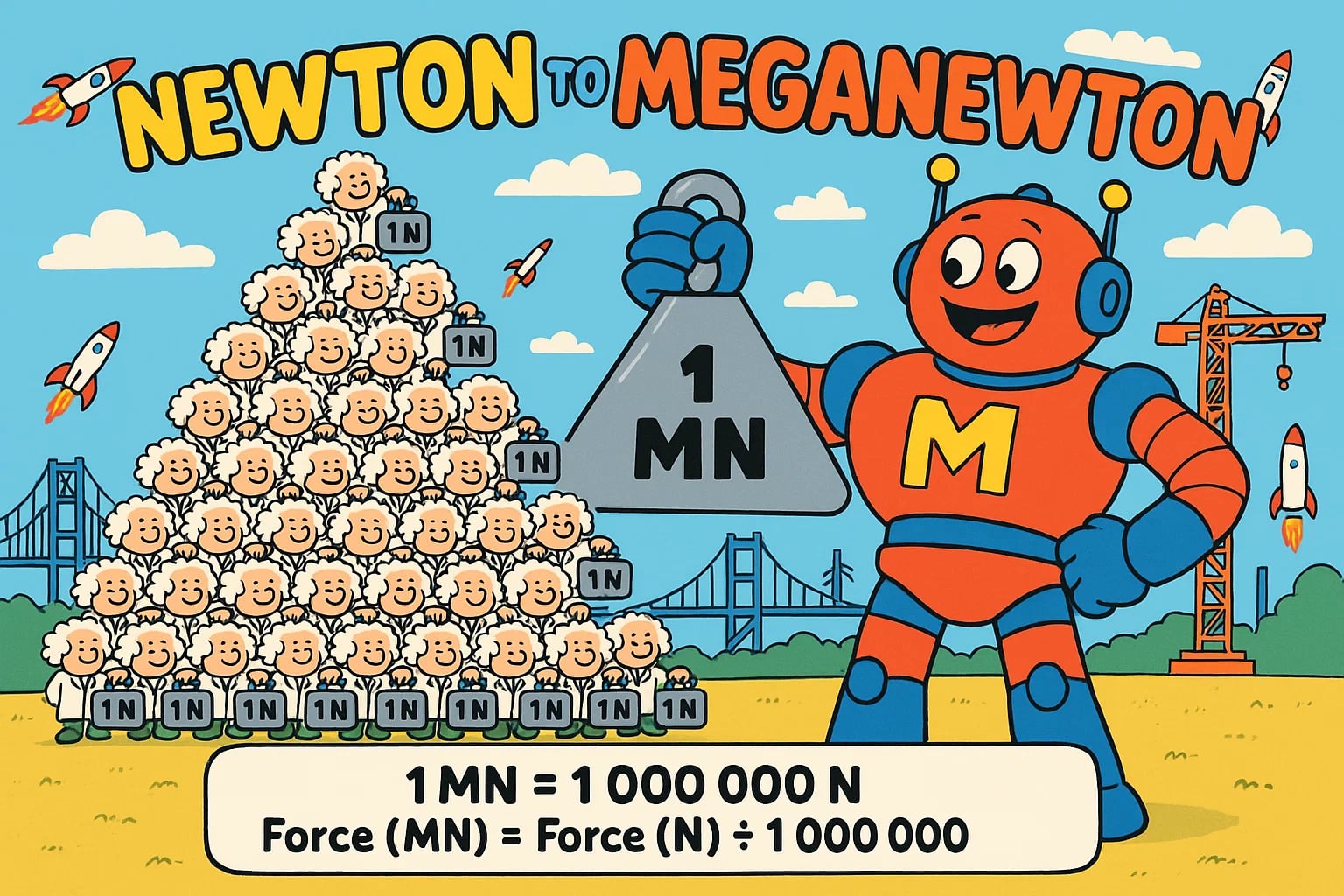Newton to Meganewton – How to convert N to MN
Need to convert newton to meganewton? Whether you’re dealing with the force of rocket engines, structural loads in megastructures, or large-scale physics simulations, understanding this conversion is critical. Let’s explore what each unit means, how to compute the conversion, and where these measurements show up in the real world.

What is a newton (N)?
The newton (N) is the SI unit of force, named after Sir Isaac Newton. One newton represents the force needed to accelerate a 1 kg mass by 1 m/s². It’s used universally in physics, mechanics, and engineering — from calculating friction on machine parts to measuring impact forces in crash testing.
For perspective, Earth’s gravity applies about 9.8 N of force on a 1 kg object at sea level.
What is a meganewton (MN)?
A meganewton (MN) is a large-scale force unit, where 1 MN = 1 000 000 N. The prefix “mega-” means one million, so a meganewton is a million newtons. These units are common in aerospace engineering, civil engineering, and space exploration, where forces reach enormous scales.
For example, the thrust produced by the Space Shuttle’s main engines at liftoff exceeded 5 MN — a force powerful enough to lift the entire launch stack off the pad.
Conversion formula
The conversion is simple because both units are SI-based:
1 MN = 1 000 000 N
Force (MN) = Force (N) ÷ 1 000 000
Example:
A rocket engine generates 2 500 000 N of thrust. To express this in meganewtons:
2 500 000 N ÷ 1 000 000 = 2½ MN.
So, 2 500 000 N = 2½ MN.
For other conversions across categories, you can explore Conversion tools or, if your calculations involve related measurements, visit the Force Converter for linked unit needs.
Did you know?
-
The Saturn V rocket, which launched astronauts to the Moon, produced about 35 MN of thrust at liftoff.
-
Bridges like the Akashi Kaikyō Bridge in Japan are designed to withstand dynamic loads measured in the hundreds of MN during storms or seismic events.
-
Commercial jet engines often produce thrust in the range of 0.25–0.5 MN, depending on model and configuration.
-
1 MN equals roughly the weight of 100 000 kg (about 220 000 lb) under Earth’s gravity.
-
The Large Hadron Collider (LHC) uses magnets that exert forces of several MN to bend and accelerate particle beams.
Scaling Up: Why Engineers Use Meganewtons
Newtons are perfect for most lab-scale physics and mechanical engineering calculations, but meganewtons are the domain of giants — rockets, bridges, heavy-lift systems, and particle accelerators.
For instance, when SpaceX’s Falcon Heavy ignites, its 27 Merlin engines generate a combined thrust of over 22 MN. Such immense forces need to be measured in MN to avoid cumbersome numbers, especially in mission planning and structural safety assessments.
On the civil side, earthquake-resistant skyscrapers often account for wind and seismic forces in the tens of MN, ensuring stability under extreme conditions. Without scaling up to MN, engineers would juggle numbers with six trailing zeros — impractical for design and documentation.

Making Mega-Scale Measurements Simple
When engineers, scientists, or project planners deal with massive forces, converting to MN streamlines calculations and communication. Instead of writing 12 000 000 N, you can express it simply as 12 MN. This improves readability and reduces errors in technical documentation.
Whether you’re designing a spacecraft, analyzing bridge loads, or working with industrial-scale hydraulics, the Jetcalculator tool makes switching between these units fast and accurate. Check out our Conversion tools or related resources like the Force Converter for other calculations involving connected unit systems.
From rockets to megastructures, converting newton to meganewton ensures your calculations stay precise — and your data easy to work with.

